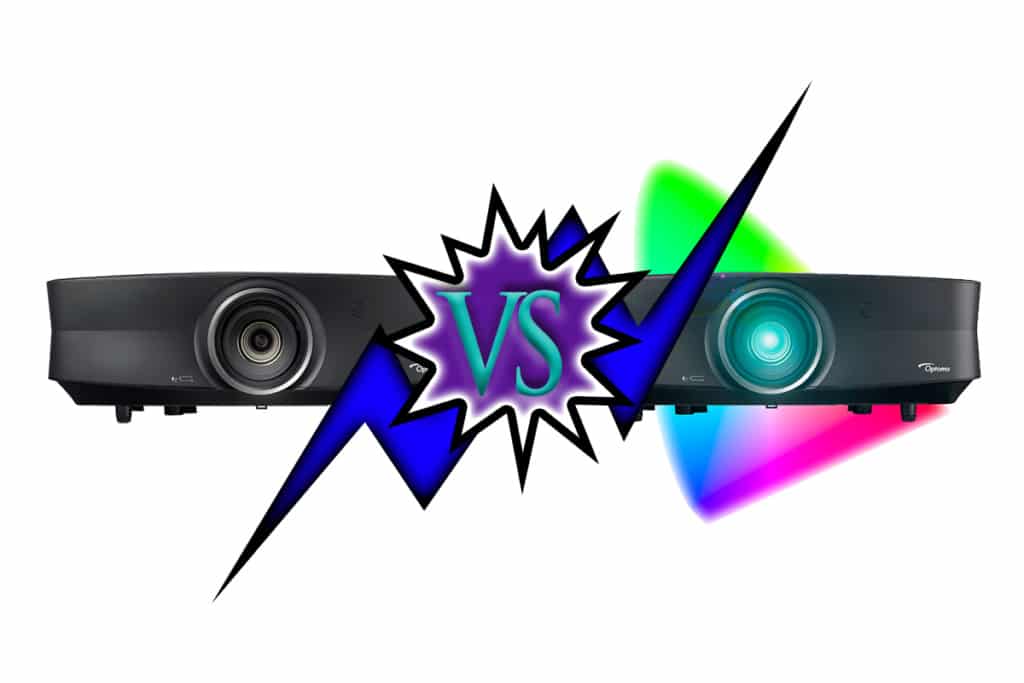AV Solutions, Home Theater
Optoma 4K UHZ65 vs THEO-Z651 (Part I)
1In compliance with Optoma, the models for the upgraded UHZ65 are now called Theo-Z65 and Theo-Z65 Lite
Introduction
The Upgraded UHZ651 is a modification and re-calibration of the Optoma UHZ65 laser 4K UHD projector. The changes are designed to increase the color gamut to achieve over 80% of the wide color gamut for the HDR standard, known as REC 2020, and to improve the black levels and contrast of the projector. The motivation for this upgrade was prompted by the fact that currently on the market most laser based 4K projectors are currently over $10K, and those which can achieve close to 80% of REC 2020 are currently over $35K. I personally love the rich color and deep reds of a wide color gamut like some high-end flat panel TVs, but had seen nothing in the market for a 4K projector at a reasonable cost.
When we first looked at the UHZ65 over a year ago, we were pleasantly surprised by the performance and immediately started to compare it to other 4K, and 4K shift, or “Enhanced 4K,” projectors. What we found was not only could it hold its own with some of the best available, but it was laser, and we understand laser projectors and had been selling professional laser projectors for almost three years. In our opinion, laser light source in a projector is a very big deal and has changed the landscape in the professional, government, and higher education markets for good. Laser light not only eliminates bulb replacements, but it holds its brightness much much longer. Even at 20,000 hours it is only one half its original brightness. That means in terms of color stability and color fidelity a laser projector will hold its calibration much longer, and does not drastically change in the first couple of hundred hours like a lamp-based projector. Once we saw the images from the UHZ65, which at the time was almost half the cost of its nearest competition, we were hooked. The UHZ65 had become a benchmark in the cost-effective 4K HDR-capable projector arena. We just wished it had a more extended color range and slightly better blacks in low level scenes, hence we spent the next 11 months working with some of the best optical engineers in the country to develop this upgraded1 version.
It is also worth mentioning that both of these projectors do have their limitations and we would not, and do not, recommend either of these projectors to serious online competitive gamers or to those 3D-enthusiasts who enjoy and want to continue to use their 3D Blu-ray discs. These projectors are for those who appreciate and enjoy high quality projected images in 4K HDR and HD sources at a reasonable cost that will last for many years without the expense of lamp changes and continued calibration adjustments.

Disclaimer
TVS Pro is neither paid by, nor compensated in any way, by any manufacturer or sponsor to do these tests and comparisons. Unlike some online product reviews, we are not influenced by, nor do we currently accept paid advertisements from, any manufacturer or distributor. Our purpose in doing these comparisons is to provide our customers and own sales team with knowledge and information, along with visual, real world, side-by-side comparisons to make informed decisions. We learned many years ago in the professional simulator and government applications that you cannot, or should not, make product decisions based on manufacturer’s specifications or isolated technical reviews when only a single projector is tested and not compared to the competition. We have also learned that price is a relative guideline to the actual performance and there are many exceptions to, “you get what you pay for,” when it comes to new technology and new innovation products.
Color & Brightness
One of the things that we really liked about the UHZ65 is the bright output of the laser light source. While most 4K home theater projectors have been in the 1,300 to 1,900 lumen range, the UHZ65 is able to output a 3,000 lumen usable image. By usable we mean the color balance is still reasonable when compared to many lamp-based projectors which, when put in their brightest modes, are yellow-green and, for most people, unwatchable. Most home screens will never need 3,000 lumens. However, when using HDR sources and better color modes than the “Bright” modes, the extra light output is much appreciated. It is also known science that to improve contrast and color it reduces the light output. By starting with so much light capability, the improvements to both color and contrast in the upgraded version1 would still result in a very usable projector for a screen up to about 140″.

In order to show the real differences in color gamut (since very few wide color gamut monitors with 80% of REC 2020 are available currently), we decided to show the actual color gamuts as captured and displayed on the calibration software.




The real test of expanded wide color gamut is the final viewing experience on a good 4K HDR disc on a display which is capable of displaying the wider color. Even though most displays you may view this comparison on are probably not capable of the additional color, some of it does seem to come through even though it is not as dramatic as seeing it in person.


There is an effort underway to come up with a new measurement of lumens for projectors with high color purity and wide color gamut. We are not aware of any current standards, but due to the above effect, we may see some in the future. If you look carefully at the image of the color bars at the beginning of this blog and look carefully at the very first 75% white bar on the left of each image you will see that, indeed, the unmodified UHZ65 is brighter even though in many of these images it is hard to see – both in person and in these images that are captured.

We found it very interesting that images from high resolution stills, like the one above and the ones which follow, seem to show even more differences than some 4K HDR movies did. We think that may be due to the fact that many 4K HDR movies are color graded to the P3 standard within the REC 2020 color gamut. Most photos are not limited to just P3 and can take advantage of the full REC 2020 color space. As more 4K HDR displays with color gamuts wider than P3 become more common, we hope to see more 4K HDR movies graded to the full REC 2020 color space, as the ACES post production workflow and others can, and do, support the full REC 2020 specification for wide color gamut.

As can be seen in the calibration charts above and visible to some extent in some of these images the wide color gamut of the Upgraded UHZ651 is a significant improvement over the standard UHZ65. Even though there is a significant reduction in white (measured lumens ) output, the difference is not very apparent to the eye even when viewing even side by side as can be seen in most of these images. From tests we have done here as well as feedback from customers who have had their UHZ65 projectors upgraded on screen sizes up to 140″, if used in a dark theater like environment, light output has not been an issue and the resultant color gamut has resulted in more dynamic and lifelike
images.
Contrast & Black Levels
One of the challenges with projector design is to balance the black level performance with good brightness. Since most improvements to black level performance will also impact the overall brightness, traditional techniques, such as adding an iris and/or light dimming, also take their toll in terms of HDR, or actual scene contrast. Optoma chose to use very conservative laser light dimming with user defined settings. For example, if the most extreme laser dimming setting is used, Dynamic Black 3, the scene can completely fade to black with no visible or measurable light on the screen. If, however, a scene with some white highlights are present, Optoma has chosen to do very little or no light dimming, which preserves a much higher level of contrast but may not yield as deep as blacks as a projector that uses an iris. Our goal in the Upgraded UHZ651 was to improve the black levels, especially in mid-to-low-light scenes, and preserve and improve the overall contrast of the image.</>

Good native contrast is a characteristic of DLP-based projectors. Even though many do not live up to their full potential, Optoma has done a good job in this design. In our “Semi Black” test we are able to evaluate the actual black level in a scene without the effects of an iris or light dimming. This is because once a scene has enough highlights (think of HDR) as brightness found in this test signal, most projector designs will not try and use their iris or light control as it will reduce the contrast and brightness of the highlights. Here our improved black levels of the Upgraded UHZ651 translate to good dynamic range and contrast.

The next couple of images are, again, side-by-side on both projectors so that any differences can be observed. As in the color test, it is very interesting to note that the improved black levels seem to attract the eye, and even though the peak highlights are not quite as bright, the eye tends to favor the higher contrast due to the improved blacks.

This next image is from another still shot at the Disney “Paint the Night Parade” just after CEDIA last year. I think we understand why the color differences are so apparent due to the pure LED lighting used in the parade, but not sure exactly why the black levels in these photos seem to show even more than the 4K HDR Blu-ray discs.

The end result of the Upgraded UHZ651, for improved black levels and contrast, was very pleasing to us and the 11 months of trial and error seems to be paying off. Those who have experienced it and those who have seen a live side-by-side demo have likewise been impressed. The improved contrast, like the improved color, comes at a price of reduced measured brightness. However, like the color, the added contrast seems to fool the eye and, to the eye at least, the slight decrease in brightness does not seem to be visible on most scenes.
Read Part II of this comparison! It covers imaging scaling, color mapping, HDR, and contrast!
Watch the comparison on YouTube!
1In compliance with Optoma, the model for the Upgraded UHZ65 is now called THEO-Z65



